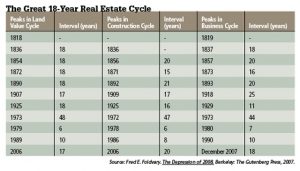Real estate prices, as with most financial markets, tend to follow a pattern. For the purpose of this article, we’ll call this pattern “The Real Estate Cycle.” There are many theories out there about The Real Estate Cycle, but the one I like best is called “The Great 18-Year Real Estate Cycle.” Back in the 30’s a real estate economist named Homer Hoyt discovered that real estate prices seemed to ebb and flow on an almost perfect 18 year schedule. Hoyt’s theory was later used and refined by now famed economist Fred E. Foldvary to predict the real estate crash of 2008. I’ll get into more depth about “The Great 18-Year Real Estate Cycle” shortly, but to me the important part isn’t necessarily the 18 year time frame, it is understanding that real estate market operates in a fairly predictable cycle that can be seen and taken advantage of by smart investors.
The Great 18-Year Real Estate Cycle
As I previously mentioned, The Great 18-Year Real Estate Cycle was originally discovered by economist Homer Hoyt. Hoyt noticed that the Chicago real estate market followed an almost perfect 18 year cycle dating back nearly 100 years. Here is a chart showing the cycle through 2007:
 As you can see the 18 year cycle theory looks great until that huge gap between 1925 and 1973. Remember, though, that Hoyt discovered his theory in the 30’s, and at that point the 18 year cycle was nearly flawless. If you were expecting a perfect cycle that allowed you to precisely time your investment and make a ton of money with no risk – sorry to disappoint. Perfect business cycles just doesn’t exist – if they did the nature of capitalism would distort them. The important part isn’t necessarily the time frame, though, the important part is that you understand the leading indicators signaling when the cycle is turning.
As you can see the 18 year cycle theory looks great until that huge gap between 1925 and 1973. Remember, though, that Hoyt discovered his theory in the 30’s, and at that point the 18 year cycle was nearly flawless. If you were expecting a perfect cycle that allowed you to precisely time your investment and make a ton of money with no risk – sorry to disappoint. Perfect business cycles just doesn’t exist – if they did the nature of capitalism would distort them. The important part isn’t necessarily the time frame, though, the important part is that you understand the leading indicators signaling when the cycle is turning.
Now that the history lesson is over, let’s get to the part that investors really care about – where are we now, and how can you make money from this? If you look strictly at the 18 year pattern, the next peak will happen sometime in the mid 2020’s – so we still have a few years. Rather than focusing on the date, though, I encourage investors to look at the fundamentals. If you dive deeper into the fundamentals you will notice that the market has for the most part leveled out. In most real estate markets across the country home prices aren’t really increasing, but the huge drops seem to be a thing of the past. If you look at affordability indexes you’ll notice how buying a home actually makes sense now – which was not the case a few years back. In fact, in many real estate markets it is actually cheaper to buy a home now than it is to rent. Interest rates are at all time lows, and mortgages are as attractive as they have ever been.
Now I’m not predicting home prices to start climbing 20% like they did back in the height of the bubble, but investors shouldn’t be banking on that anyway. Smart investors in today’s market can see that with mortgage rates ridiculously low, and property prices back at reasonable levels, they can purchase homes at extremely high cap rates – which means cash flow. They aren’t banking on appreciation to make money – they are making money every month from rental income.
Let’s assume that the next peak will happen sometime around 2025 – that gives us about another 13 years before the bubble pops to take advantage of the down part of the real estate cycle. Want to know a good plan for retirement? How about you buy as much property as you can, ride out the next 10 years enjoying your cash flow, and then sell when the market starts to peak again in the mid 2020’s? Sure beats working till you’re 80, which by the way, is what some experts believe the new retirement age needs to be – scary huh?